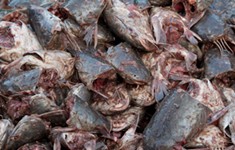
“The amount of food wasted and lost around the world is staggering,” said Tim Fox, the institution’s head of energy and environment. “This is food that could be used to feed the world’s growing population, as well as those in hunger today.”
In terms of seafood, the FAO has estimated that 40 to 50 million MT, or about one-third, of the 150-160 million MT of fish and shellfish harvested annually are lost to human consumption in some way.
In underdeveloped countries the wastage is caused by poor handling including transport and storage infrastructure. Africa is a prime example where fish are not treated properly. Said a fisheries consultant working there: “Fish transported between some [African] countries is carried in unrefrigerated vehicles which are often held up for days at borders by customs officials.”
Processing methods are also inadequate, he added. “Fish is put out to dry in the sun where it is contaminated by rats and birds.”
In developed countries, wastage usually occurs much further along the chain, often right at the consumer end. The report blames supermarket selling methods where customers are persuaded to buy more than they need through “buy one get one free” offers, then there are large packs which are promoted as being “better value for money,” etc.
Sell by dates marked on packs are too strict say the report’s authors, who add that consumers are overly cautious. Consumers also frequently confuse “sell by” dates with “use by” dates and so shorten the time that perfectly safe to eat products are kept in the home.
And there is yet another date often marked on packs which confuses consumers even more. The “best before” date is self explanatory, but some consumers think “best before, poisonous after.”
A Norwegian fisheries executive believes that the introduction of sell by dates is “one of the really criminal things we have done in the industrial world.
“I talked to the owner of one of the largest supermarket chains in Norway, Rema 1000, and suggested he should donate expired food to the poor etc. He said: ‘Yes it would be nice, but some journalist would surely hang me out to dry for giving bad food to the poor. So we throw away hundreds of MT of perfectly good food every day.’”
Toine Timmermans, from Wageningen University and Research Centre in the Netherlands, said that after years of research he finds the conclusion about the amount of food waste (1.2 to 2 billion MT) unrealistically high. However, he describes the IME publication as a “relevant report that draws attention to an important issue and topic.”
And this it certainly does. It is commonly said that more than half the world’s population is starving, and as the world’s population is expanding at an alarming rate, the number of starving people will only increase. It is therefore imperative that we make the most use of all the food that we harvest.
And here the seafood industry has much to learn. In some countries there is still no attempt to make products from the trimmings, etc. from processing. One tilapia operation in Asia failed financially because this material was not utilized. Said a former director: “We didn’t use it so we couldn’t get [the operation] to pay. We have got to use everything in fisheries.”
This is a must. The amount of fish we catch from the wild won’t increase; the amount of fish produced from aquaculture will be limited by technological factors and probably environmental ones as well. There will certainly be a shortfall in years to come as there are more and more mouths to feed.





